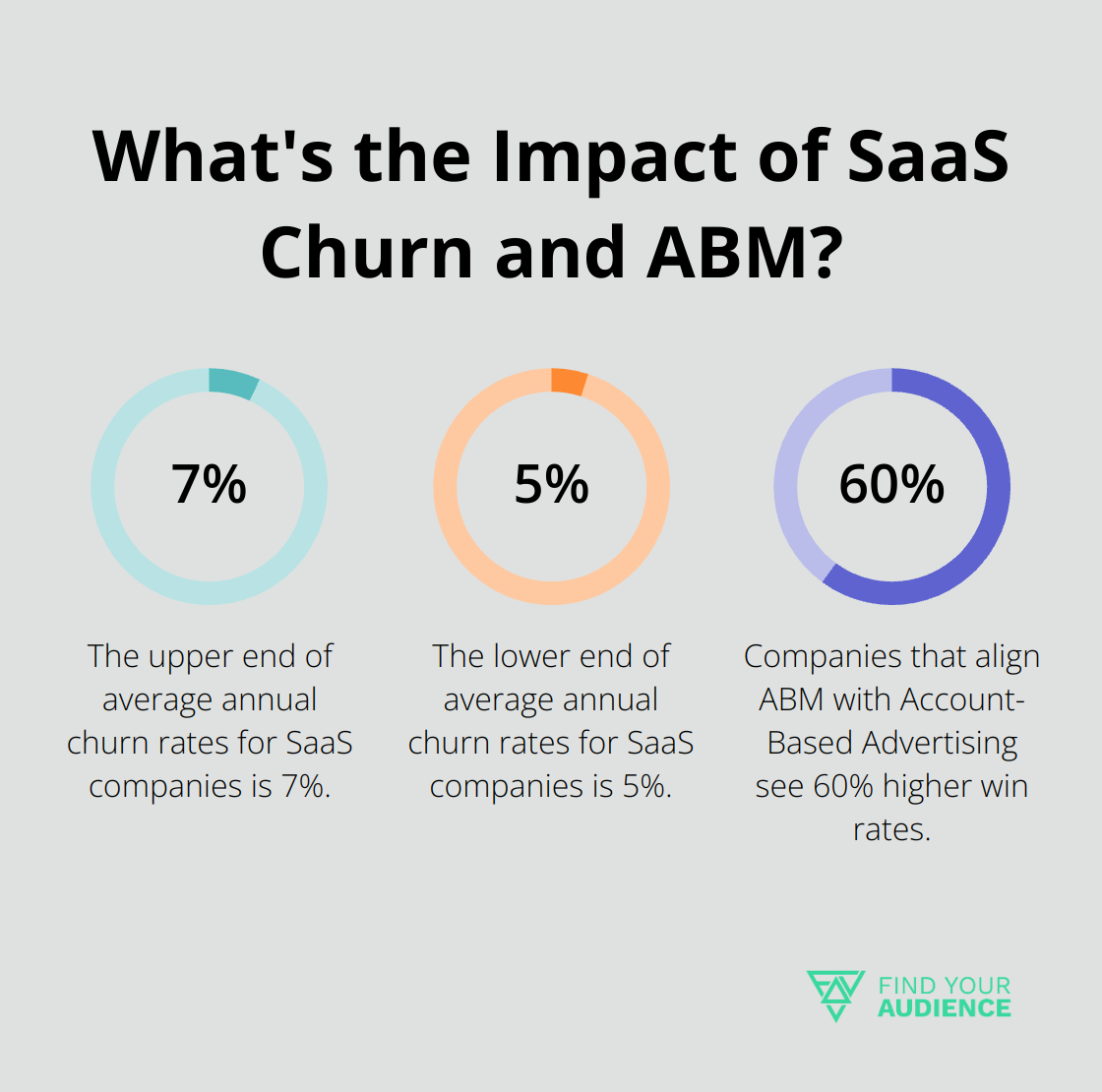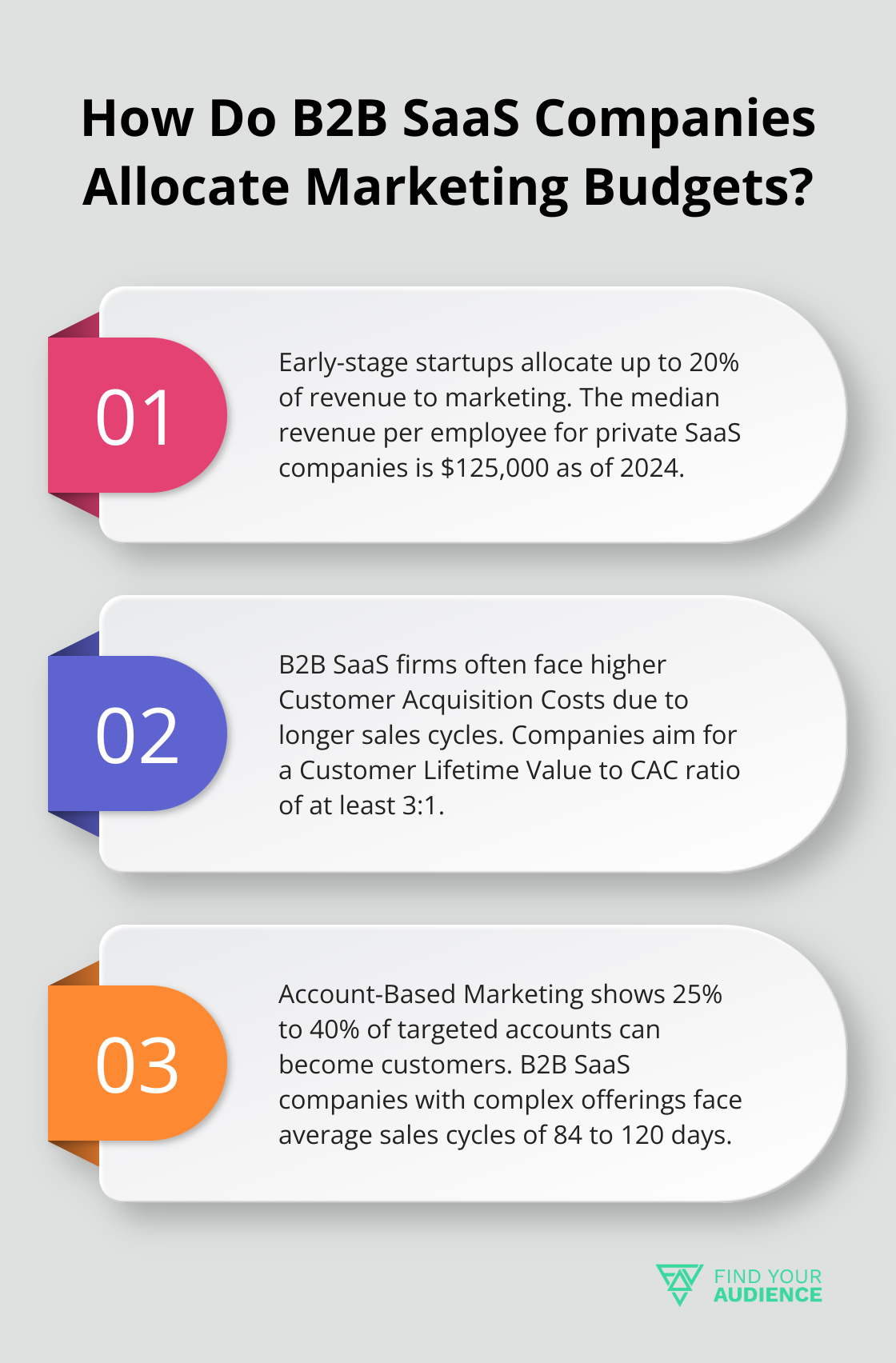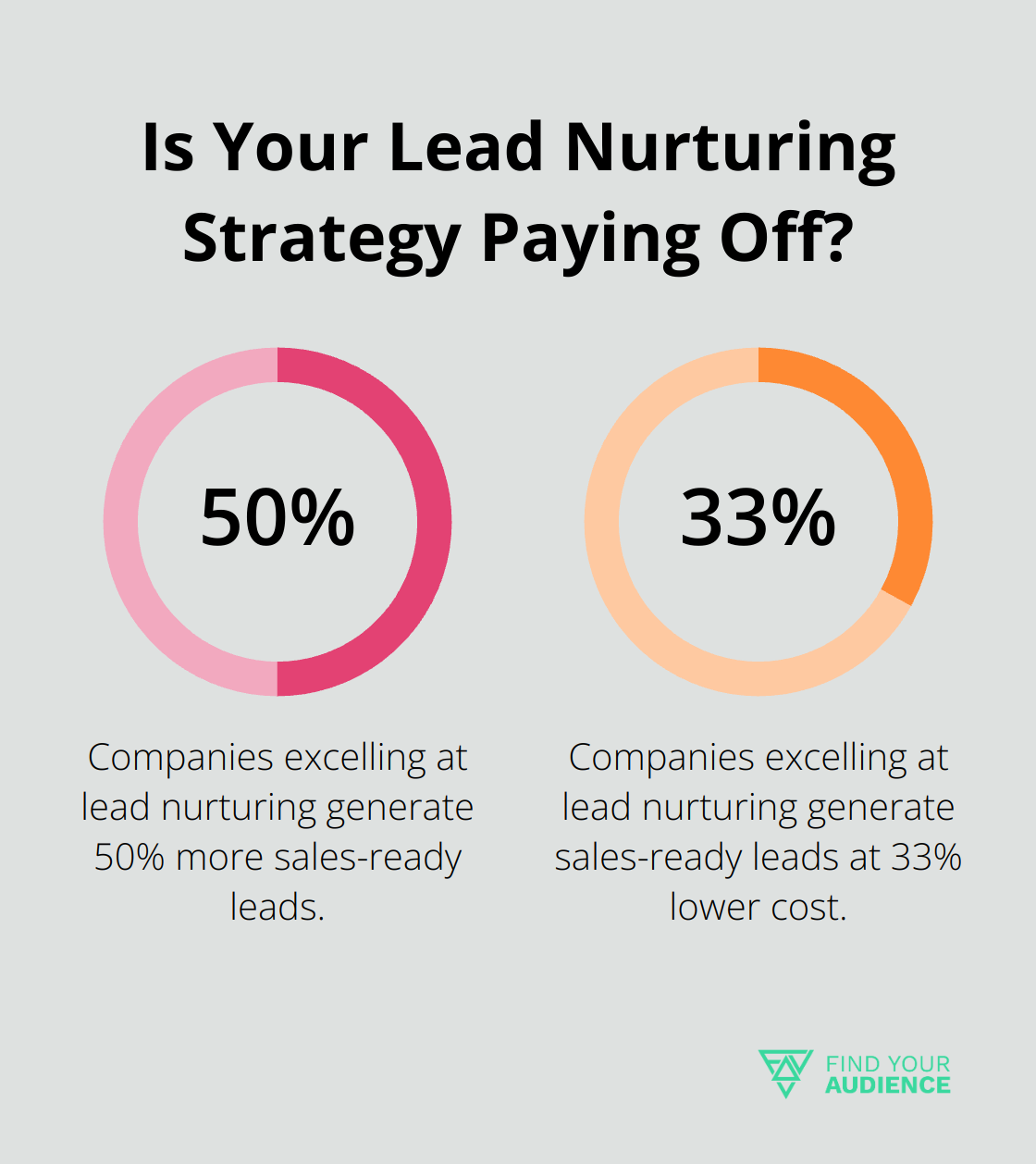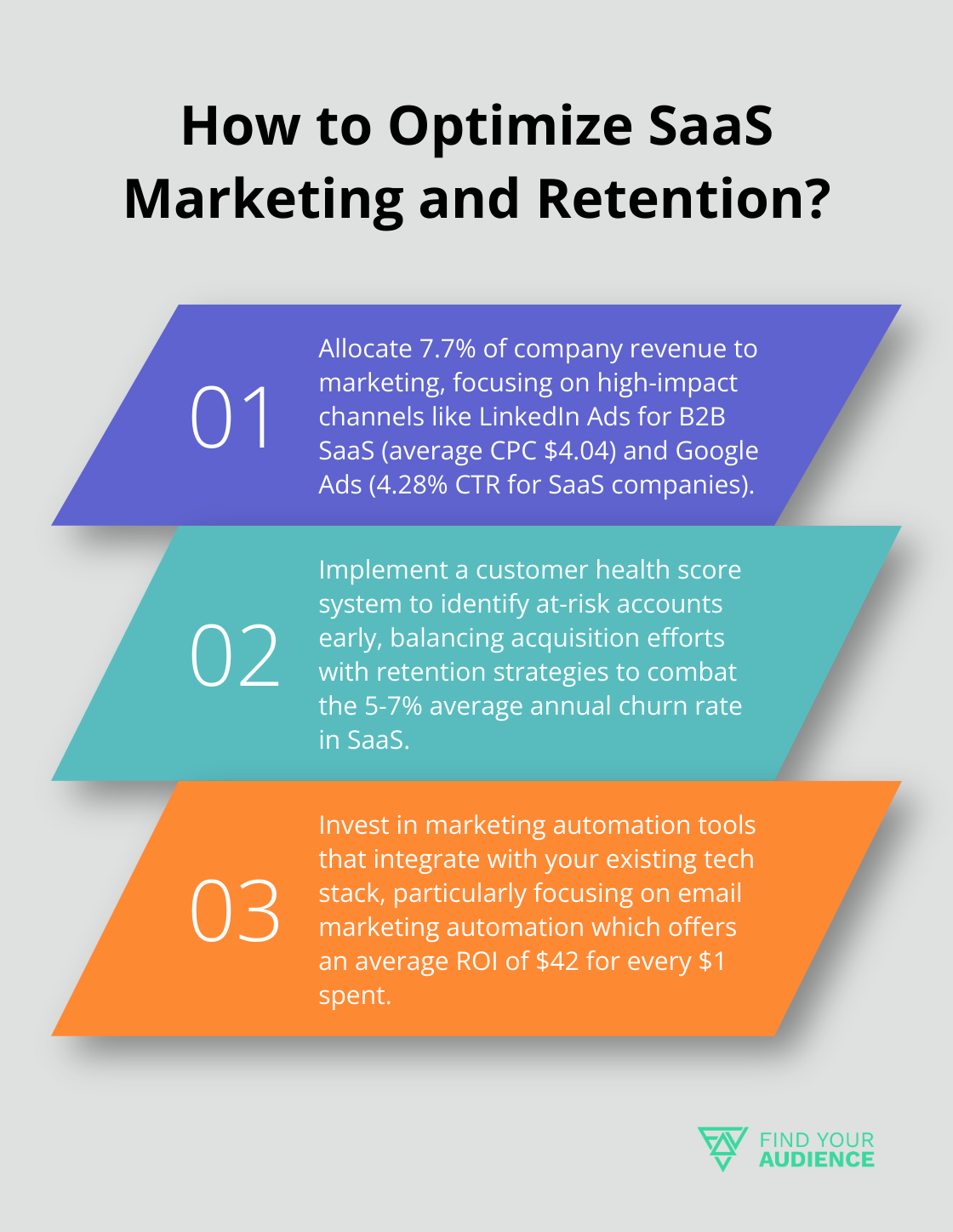SaaS Marketing Spend: Industry Benchmarks Revealed
SaaS marketing spend benchmarks are crucial for companies looking to optimize their growth strategies. At Find Your Audience, we’ve seen firsthand how understanding these metrics can make or break a SaaS business.
In this post, we’ll reveal industry standards, explore key factors influencing marketing budgets, and share strategies for maximizing your marketing ROI. Get ready for actionable insights that will transform your SaaS marketing approach.
Current SaaS Marketing Spend Benchmarks
Shifting Landscape of Marketing Budgets
SaaS companies must adapt their marketing budgets to remain competitive. Gartner’s 2024 CMO Spend Survey reveals a significant shift: marketing budgets have decreased from 9.1% of company revenue in 2023 to 7.7% in 2024. This 15% year-over-year drop underscores the need for SaaS businesses to optimize their marketing spend.
Channel-Specific Allocation Trends
SaaS companies distribute their marketing investments across various channels. SaaS Capital’s report indicates that the median percent of annual recurring revenue spent on marketing is 8%, down from 10% the previous year.

Digital advertising claims a substantial portion of SaaS marketing budgets. Google Ads generate the highest click-through rates (CTR) at 4.28%, despite a median cost of $1,978.68 per month for SaaS companies. LinkedIn Ads, while more expensive with an average cost-per-click (CPC) of $4.04, offer targeted reach for B2B SaaS firms.
Content marketing and SEO remain essential, with many SaaS companies allocating substantial resources to these areas. The median number of organic clicks for SaaS websites was 1.05K in November 2023, indicating potential for improvement in organic search strategies.
B2B vs B2C SaaS Marketing Spend Comparison
B2B and B2C SaaS companies often exhibit different marketing spend patterns due to their unique target audiences and sales cycles. B2B SaaS firms typically face higher customer acquisition costs (CAC) and longer sales cycles, which can range from 84 to 120 days on average.
For B2B SaaS, Account-Based Marketing (ABM) gains traction. According to the 2024 ABA Survey Report, companies that align ABM with Account-Based Advertising see 60% higher win rates.
B2C SaaS businesses often focus more on rapid user acquisition and viral marketing strategies. They typically allocate a larger portion of their budget to social media advertising and influencer partnerships to reach a broader consumer base quickly.
Both B2B and B2C SaaS companies increasingly prioritize customer retention. With average annual churn rates between 5% and 7%, investing in customer success and retention marketing becomes as important as acquisition efforts.
These benchmarks provide a useful reference point, but SaaS companies must tailor their marketing spend to their specific growth stage, target market, and business model. The next section will explore the key factors that influence SaaS marketing spend, helping you make informed decisions about your budget allocation.
What Drives SaaS Marketing Spend?
SaaS marketing spend depends on various factors. Understanding these drivers helps companies optimize their marketing budgets and achieve sustainable growth.
Growth Stage Impacts Budget Allocation
A SaaS company’s stage significantly affects its marketing expenditure. Early-stage startups often allocate up to 20% of their revenue to marketing to gain market traction. As companies mature, this percentage typically changes. As of 2024, the median revenue per employee for private SaaS companies is $125,000. However, it’s important to note that this figure can vary significantly based on factors such as company size and growth stage.
Customer Acquisition Costs Fluctuate
Customer Acquisition Cost (CAC) plays a pivotal role in SaaS marketing. The simplest way to calculate CAC is to divide your total marketing and sales spend by your total number of new customers. B2B SaaS firms often face higher CACs due to longer sales cycles and more complex decision-making processes. Companies should try to achieve a Customer Lifetime Value (CLTV) to CAC ratio of at least 3:1 to justify these costs.
Market Saturation Requires Creative Strategies
Saturated markets force SaaS companies to innovate their marketing strategies. This often leads to increased spending on differentiated campaigns and channels. Account-Based Marketing (ABM) has gained popularity in B2B SaaS, with success rates showing that 25% to 40% of targeted accounts can become customers. However, this approach often requires higher upfront investment in personalized content and targeted advertising.
Product Complexity Lengthens Sales Cycles
The complexity of a SaaS product directly impacts the sales cycle length and, consequently, marketing spend. B2B SaaS companies with complex offerings face average sales cycles of 84 to 120 days. This extended timeline necessitates sustained marketing efforts throughout the buyer’s journey, often resulting in higher overall marketing budgets. Companies must balance short-term lead generation tactics with long-term brand building to effectively nurture prospects through lengthy decision processes.
Competitive Landscape Shapes Strategy
The competitive environment in the SaaS industry significantly influences marketing spend. In highly competitive markets, companies often increase their marketing budgets to maintain visibility and market share. This may involve investing in thought leadership content, participating in industry events, or launching aggressive advertising campaigns. The intensity of competition can push companies to explore innovative marketing channels and technologies (such as AI-driven personalization) to gain an edge.

These factors interplay to shape SaaS marketing budgets. The next section will explore strategies for optimizing marketing spend based on these drivers.
How to Maximize Your SaaS Marketing ROI
Focus on High-Impact Channels
Identify which marketing channels deliver the best results for your specific SaaS product. SaaS Capital’s report suggests that a growth rate of 30% for a $4 million SaaS business is below the median, while growth of 30% for a $20 million SaaS business is above the median. It’s not just about how much you spend, but where you spend it.

For B2B SaaS, LinkedIn Ads often yield high returns despite a higher average CPC of $4.04. The platform’s targeting capabilities make it ideal for reaching decision-makers. Google Ads generate an impressive 4.28% CTR for SaaS companies, making it a strong contender for your ad budget.
Content marketing and SEO remain cost-effective for long-term growth. With SaaS websites averaging 1.05K organic clicks monthly, there’s room for improvement. Invest in high-quality, problem-solving content to boost your organic traffic and lead generation.
Balance Acquisition and Retention
Customer acquisition is important, but don’t neglect retention efforts. With average annual churn rates between 5% and 7%, investing in customer success can significantly impact your bottom line. Try to achieve a healthy balance between acquisition and retention spending.
Implement a customer health score system to identify at-risk accounts early. This proactive approach allows you to allocate resources more effectively, reducing churn and increasing lifetime value.
Leverage Marketing Technology
Marketing automation is no longer optional in SaaS. It’s a necessity for scaling your efforts and improving efficiency. Invest in tools that integrate with your existing tech stack and provide clear ROI.
Implement a robust CRM system to improve lead nurturing and conversion rates. Forrester reports that companies excelling at lead nurturing generate 50% more sales-ready leads at 33% lower cost.
Email marketing automation remains a high-ROI channel for SaaS (with an average ROI of $42 for every $1 spent). Use behavioral triggers and personalization to improve engagement and conversion rates.
Select and master the tools that align with your specific marketing objectives and customer journey, rather than trying to use every available tool.
Optimize Based on Data
Use data-driven insights to continuously test, measure, and optimize your marketing efforts. Track key performance indicators (KPIs) such as Customer Acquisition Cost (CAC), Customer Lifetime Value (CLTV), and conversion rates across different channels.
Regularly analyze these metrics to identify trends and areas for improvement. This data-centric approach allows you to make informed decisions about budget allocation and strategy adjustments.
Embrace Personalization
Personalize your marketing efforts to increase engagement and conversion rates. Use customer data to tailor your messaging, content, and offers to specific segments of your audience.
Implement account-based marketing (ABM) strategies for high-value prospects. This targeted approach can lead to higher conversion rates and more efficient use of your marketing budget.
Final Thoughts
SaaS marketing spend benchmarks continue to evolve, with recent data showing a decrease from 9.1% to 7.7% of company revenue allocated to marketing. This shift underscores the importance of strategic spending for SaaS businesses. Factors such as growth stage, customer acquisition costs, and market dynamics significantly influence marketing strategies and budgets.

We expect personalization, account-based marketing, and AI-driven tools to gain prominence in SaaS marketing. These trends will likely reshape budget allocations, with a growing emphasis on customer retention and lifetime value. Companies that adapt to these changes will position themselves for sustainable growth in the competitive SaaS landscape.
Find Your Audience offers tailored solutions to help SaaS companies navigate marketing challenges and drive pipeline growth. Our team can support various aspects of your marketing strategy, from content production to full marketing department experiences. Visit our website to learn how we can optimize your SaaS marketing approach and maximize your ROI.

